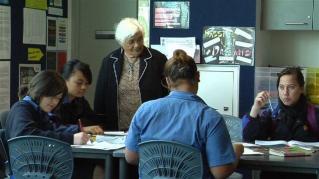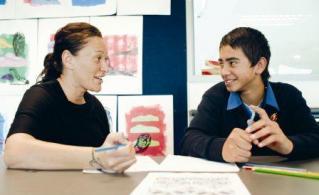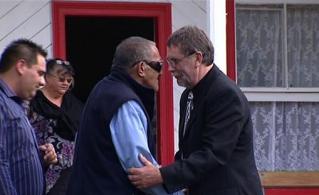Section navigation
Selecting topics and contexts
Te Mana Kōrero 1
- What examples of teachers making strategic decisions about topic and context selection do you note? What appears to be the outcome of making these decisions?
[Note the teacher at Ruawai Primary School who requires her students to retell a legend around a local landmark. She notes that the unit of work “went very well because it was very local. Students can now associate the rocks with the legend. They are aware of the history behind them.” She implies that the success of the unit depended on the students relating to the context.
Note also the teacher at Kapiti College who explored the carvings around the school’s wharenui with his students because they represent the students’ tīpuna. He believes that promoting learning through his students’ life contexts enables them to develop a sense of pride in themselves and to become more aware of other students’ cultures.]
Te Mana Kōrero 3
- How do teachers decide on topics or contexts that students might relate culturally to? What are some of those topics or contexts? How do the teachers involve students in topic selection? How does this enhance whānau engagement in the learning of their tamariki?
[Note examples of teachers selecting topics that students relate culturally to, how teachers involve students in topic selection, and what teachers (and students) see as the benefits of culturally-appropriate topic selection.
Tologa Bay Area School: teacher changes class learning topic from ‘coal mining’ to ‘pounamu’. She does this because she recognises that the pounamu her students are wearing is precious to them and she believes that they will find this topic more relevant to their lives than ‘coal mining’. Note students’ comments that their families were able to participate in the study (largely through sharing knowledge). They had cultural knowledge that was appropriate and valid to learning and assessment: “There was a body of knowledge that kids could access and Māori knowledge could be validated in the mainstream”. Also note the teacher’s comment, “I would do it again (select another culturally-connected learning unit) … It leads to higher grades and the students are more interested in the topic.”
From the same school, note example of student delivering a speech on Witi Ihimaera because she is passionate about him as a writer.
Also note examples of Opunake School selecting topics such as ‘bush survival’ and ‘creation myths’ because of their potential for community participation, e.g., whānau member working with tamariki on survival in the bush; and students questioning their parents about the Rangi and Papa myth (“When I was talking about this with my Mum …”). But also note a parent’s comment that Māori-related topic selection needs to be “subtle, not in your face” because “there are non-Māori families at this school.”]
-
How do teachers find out what questions are important to the students in their class? What do they do with this information? How do they help students discover answers to their questions? How does this help whānau to engage with the learning of their tamariki? [Note example at Opunake School of principal describing how, at the beginning of each school year, teachers:
ask their students, “What are your concerns about yourself?”, “What are your concerns about your family?”, “What are your concerns about the world?”, and “What are your concerns about the environment?” - Use these responses to develop learning units (integrated studies)
- Ask their students how they would like to find out answers to their questions
- Negotiate approaches to learning with students (their main preferences are: talking with visitors, hands-on learning, trips, and exploring/inquiry learning).
Teachers working with students to form and answer questions about their own lives has good potential for whānau involvement.
Also note the Tologa Bay Area School teacher’s comment, “The most profound way to create a culturally responsive context is through introducing co-construction where the student is free to bring their own experiences into the classroom context.”]


